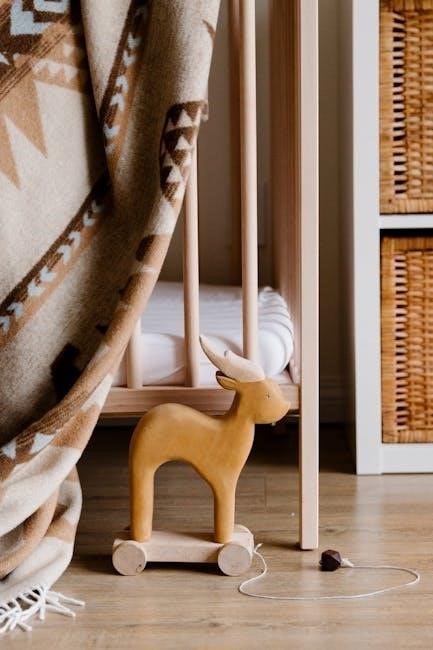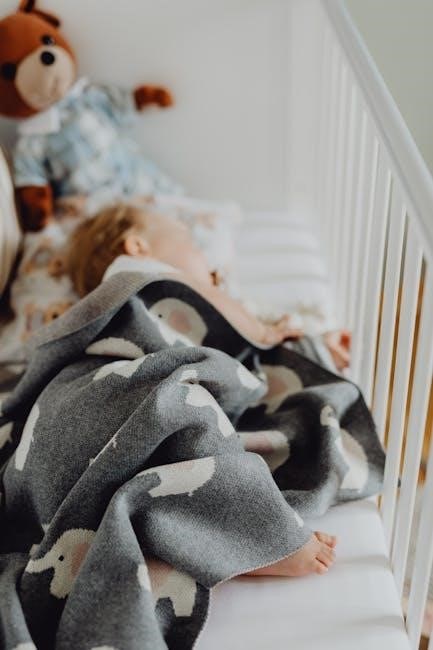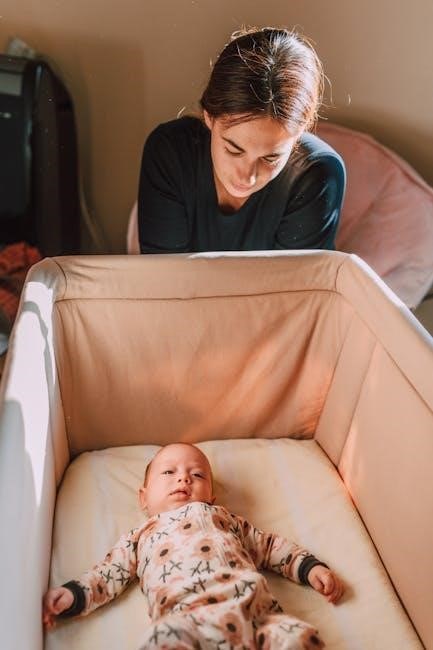Jenny Lind Crib Instructions: A Comprehensive Guide
Welcome! This guide unravels the secrets of the Jenny Lind crib, embracing the joy of preserving a piece of family history. From classic spindles to meticulously aligning each piece, we’ll journey into the past.
Embark on assembling your Jenny Lind crib with this comprehensive guide. Even though assembling a cot may seem difficult, many cribs include easy-to-follow instructions; It is possible to assemble a crib yourself! It’s easy to figure out how to follow the original instructions. You should be able to put the crib together within one hour. It may take longer if you have to search for parts. Before you begin, ensure the crib hasn’t been recalled for safety reasons. This guide will help revive the Jenny Lind crib, unveiling the secrets of its construction. From identifying the classic spindles to meticulously aligning each piece, this process transcends mere assembly. Check this product for damaged hardware, loose joints, loose bolts or other fasteners, missing parts, or sharp edges. Failure to follow these warnings and assembly instructions could result in serious injury or death. Read all instructions before assembling crib. Keep instructions for future use. Do not use this crib if you cannot exactly follow the instructions that come with it. We embark on the task of reviving the Jenny Lind crib, unravelling the secrets of its construction and embracing the joy of preserving a piece of family history.

Identifying Components and Parts
Before you start, let’s identify all the components. Ensure you have the necessary parts: headboard, footboard, side panels, mattress support, and all required hardware. Check for any damaged parts before proceeding. Knowing each piece is crucial for smooth assembly.
Overview of Necessary Parts
Let’s delve into the essential components needed for a successful Jenny Lind crib assembly. First, you’ll require the headboard and footboard, which form the main structure at either end of the crib. These are often characterized by their spindle design, a signature feature of Jenny Lind cribs, adding to their vintage charm. Next are the side panels, connecting the headboard and footboard to create the crib’s length. These panels usually mirror the spindle design of the headboard and footboard, maintaining a consistent aesthetic.
A crucial component is the mattress support, which provides a stable and secure base for the baby’s mattress. This support may consist of a metal frame with springs or a solid wooden platform. It is important to ensure that this support is correctly installed to prevent any safety hazards. Additionally, you’ll need the appropriate hardware, including screws, bolts, and barrel cams. The barrel cams are essential for securely connecting the side panels to the headboard and footboard, ensuring a robust and stable crib structure. Always refer to the manufacturer’s instructions for the specific types and quantities of hardware required. Missing or incorrect hardware can compromise the crib’s safety.
Finally, it’s wise to have a Phillips screwdriver readily available, as this is typically the primary tool needed for tightening the screws and bolts. Some models may require additional tools, so consulting the manual beforehand is advisable. Before beginning the assembly process, carefully check that you have all the necessary parts and hardware. This will save you time and prevent frustration during assembly. If any parts are missing or damaged, contact the manufacturer or retailer immediately to obtain replacements. Remember, a complete and undamaged set of parts is essential for a safe and properly assembled Jenny Lind crib.

Step-by-Step Assembly Instructions
Follow these detailed instructions to safely assemble your Jenny Lind crib. Each step is designed for clarity, ensuring a secure and stable construction. Refer to your specific model’s manual for precise diagrams and hardware details for guidance.
Headboard and Footboard Installation
Begin by laying the headboard on the floor in front of you. Ensure you have ample space to work comfortably. Identify the headboard and footboard – the headboard is typically taller and more decorative. Next, locate the necessary hardware, including bolts, washers, and Allen wrenches. Refer to the parts list in your manual to confirm you have all required components.
Carefully align the headboard with the side panels. Note the pre-drilled holes on both the headboard and the side panels. These holes are crucial for proper alignment and secure attachment. Insert the bolts through the pre-drilled holes, attaching the side panels to the headboard. Use washers to protect the wood and ensure a tight, even connection. Tighten the bolts using the Allen wrench, but do not overtighten, as this could damage the wood. Ensure the headboard is flush with the side panels.
Repeat the process for the footboard. Align the footboard with the opposite ends of the side panels, ensuring the pre-drilled holes match up. Insert the bolts, add washers, and tighten with the Allen wrench. Again, avoid overtightening. Double-check that both the headboard and footboard are securely attached to the side panels. The structure should now be able to stand freely, though it will not yet be stable until the next steps are completed. Verify all connections are snug and there are no gaps. This is a crucial step for the overall safety and stability of the crib.
If your crib features decorative caps or moldings for the headboard and footboard, now is the time to attach them. These often snap into place or are secured with small screws. Consult your manual for specific instructions. Once the headboard and footboard are fully installed, give the entire structure a gentle shake to ensure everything is secure. If you notice any wobbling or loose connections, re-tighten the bolts as needed. This meticulous approach is essential for creating a safe sleeping environment for your child.
Side Panel Attachment
With the headboard and footboard now securely in place, the next crucial step is attaching the side panels. These panels provide the necessary enclosure and support for the crib. Before you begin, double-check that you have the correct side panels. They should be identical in size and shape. Identify the pre-drilled holes along the inside edges of the headboard and footboard where the side panels will connect.
Carefully position one side panel against the headboard and footboard, aligning the pre-drilled holes. Insert the appropriate screws or bolts through the holes, securing the panel to the headboard and footboard. Use a screwdriver or Allen wrench, as specified in your instruction manual, to tighten the screws or bolts. Ensure they are snug but not overtightened, as this could strip the threads or damage the wood.
Repeat the process for the second side panel. Align the panel with the remaining pre-drilled holes on the headboard and footboard. Insert the screws or bolts and tighten them securely. As with the first panel, avoid overtightening. Once both side panels are attached, inspect all connections to ensure they are firm and flush. There should be no gaps or wobbling.
If your Jenny Lind crib features barrel cam connectors, insert one barrel cam into the side panel, ensuring its opening aligns with the through-hole. Fit the side panel over the corresponding cam screw attached to the end panel. Fasten the barrel cam with a set screw. This type of connection provides extra stability and a clean, finished look.
After attaching both side panels, carefully inspect the entire structure. Ensure that all screws and bolts are properly tightened and that the side panels are securely fastened to the headboard and footboard. Gently shake the crib to check for any instability. If you detect any movement, re-tighten the connections as needed. Secure side panels are paramount for the safety of your child, so take your time and ensure everything is correctly assembled according to the manual.
Mattress Support Installation
With the headboard, footboard, and side panels securely assembled, the next step is installing the mattress support. This component provides a stable and safe surface for the crib mattress. Before you begin, locate the mattress support frame or platform and any accompanying hardware, such as support brackets, screws, or bolts. Consult your Jenny Lind crib’s instruction manual to identify the specific parts and installation method for your model.
Most Jenny Lind cribs offer adjustable mattress heights, allowing you to raise or lower the mattress as your baby grows. Determine the desired mattress height based on your baby’s age and development. Newborns typically require a higher mattress position for easier access, while older babies who can sit or stand need a lower position to prevent them from climbing out. Once you’ve selected the appropriate height setting, align the support brackets with the corresponding slots or holes inside the crib’s side panels.
Attach the support brackets to the side panels using the provided screws or bolts. Ensure that the brackets are securely fastened and level. If your crib uses a mattress support frame, carefully place the frame onto the support brackets. Make sure the frame sits evenly and is properly aligned within the crib. If your crib uses a solid mattress support platform, position the platform onto the support brackets, ensuring it is centered and stable.
Some Jenny Lind crib models utilize corner supports for added stability. Insert one corner support into each corner of the crib assembly as shown in your manual. These supports help distribute weight evenly and prevent the mattress support from sagging. After installing the mattress support, double-check all connections to ensure they are tight and secure. Gently press down on the mattress support to test its stability. It should feel firm and level.
Finally, carefully place the crib mattress onto the installed support. Ensure that the mattress fits snugly within the crib, leaving no gaps between the mattress and the side panels. A properly fitted mattress is essential for your baby’s safety. Refer to the crib’s safety guidelines to ensure the mattress meets the recommended size and thickness requirements.

Safety Precautions and Warnings
Ensuring your baby’s safety is paramount when assembling and using a Jenny Lind crib. Before you begin, carefully read and understand all safety precautions and warnings provided in the manufacturer’s instructions. Failure to follow these guidelines could result in serious injury or death. Always keep the instructions for future reference.
Regularly inspect the crib for damaged hardware, loose joints, loose bolts, or other fasteners, missing parts, or sharp edges. Tighten any loose hardware immediately and replace any damaged or missing parts with genuine replacement parts from the manufacturer. Never use substitutes, as they may not meet safety standards.
Ensure that the mattress fits snugly within the crib, leaving no gaps between the mattress and the side panels. A gap larger than two fingers’ width can pose a suffocation hazard. Use a crib mattress that is specifically designed for the size of your Jenny Lind crib and meets the recommended thickness guidelines.
Do not place the crib near windows where cords from blinds or curtains could pose a strangulation hazard. Keep all cords and strings out of reach of your baby. Similarly, avoid placing the crib near heaters, radiators, or other heat sources that could create a fire hazard.
Never use the crib if you cannot exactly follow the instructions that came with it. If you are missing any instructions or have any questions about the assembly process, contact the manufacturer for assistance. Do not attempt to modify the crib in any way, as this could compromise its structural integrity and safety.
Once your baby can pull themselves up to a standing position, lower the mattress to the lowest setting to prevent them from climbing out. Never leave your baby unattended in the crib with the side rail lowered. As your child grows, consider transitioning them to a toddler bed or other appropriate sleeping arrangement.
Be aware of potential hazards inside the crib. Do not place pillows, blankets, or soft toys in the crib with your baby, as these can increase the risk of suffocation. Use a firm, flat mattress and a fitted sheet that is specifically designed for cribs.
Check for recalls. Make sure the crib you are setting up was not recalled or pulled from the market for safety reasons! The U.S. Consumer Product Safety Commission (CPSC) website provides information on recalled cribs and other baby products.

Troubleshooting Common Assembly Issues
Assembling a Jenny Lind crib can sometimes present challenges, but with patience and a little troubleshooting, most issues can be resolved. Here are some common assembly problems and their solutions:
Missing Parts: Before you begin, carefully inventory all the components and parts listed in the instruction manual. If you discover that a part is missing, contact the manufacturer or retailer immediately to request a replacement. Do not attempt to substitute missing parts with generic hardware, as this could compromise the crib’s safety and structural integrity.
Incorrectly Aligned Parts: Ensure that all parts are properly aligned before tightening any screws or bolts. If parts seem misaligned, double-check the instruction manual to ensure that you are assembling them in the correct order and orientation. Loosen any fasteners and try repositioning the parts until they align correctly.
Difficulty Inserting Screws or Bolts: If you are having trouble inserting screws or bolts, avoid forcing them, as this could strip the threads or damage the surrounding wood. Try using a lubricant, such as a small amount of soap or wax, to help the fasteners slide in more easily. Make sure you are using the correct size and type of screwdriver or wrench for the fasteners.
Wobbly or Unstable Crib: Once the crib is fully assembled, check for any wobbling or instability. If the crib is not level, adjust the levelers on the bottom of the legs until the crib sits firmly on the floor. Tighten all screws and bolts to ensure that the frame is secure.
Damaged Parts: If you discover any damaged parts during the assembly process, do not use them. Contact the manufacturer or retailer to request replacement parts. Using damaged parts could compromise the crib’s safety and structural integrity.
Confusing Instructions: If you find the instruction manual difficult to understand, try searching online for additional resources, such as videos or forums, that may provide clearer instructions or alternative assembly methods. You can also contact the manufacturer’s customer service department for assistance.
Tightening Fasteners: Ensure that all screws and bolts are tightened securely, but avoid over-tightening them, as this could damage the wood or strip the threads. Use the appropriate tools and apply firm, even pressure when tightening fasteners.
If you encounter any other assembly issues that are not addressed here, consult the instruction manual or contact the manufacturer for assistance. Do not attempt to modify the crib or force any parts into place, as this could compromise its safety and structural integrity.
Finding Replacement Parts and Manuals
If you’ve misplaced a part during assembly or require a new instruction manual for your Jenny Lind crib, don’t worry – obtaining replacements is often a straightforward process. Here’s how to locate both:
Contact the Manufacturer: The first and most reliable source for replacement parts and manuals is the crib’s manufacturer. Check the crib itself, the original packaging, or your purchase receipt for the manufacturer’s name and contact information. Many manufacturers have websites with online parts ordering systems or customer service departments that can assist you in obtaining the necessary items. Be prepared to provide the crib’s model number, serial number, and a description of the part you need.
Check the Retailer: If you purchased the crib from a retailer, such as a baby store or online marketplace, they may also be able to assist you in obtaining replacement parts or manuals. Contact their customer service department and provide them with the purchase details and the specific items you need. Some retailers may have partnerships with manufacturers that allow them to directly order replacement parts on your behalf.
Online Resources: Numerous online resources can help you find replacement parts and manuals for Jenny Lind cribs. Websites like ManualsLib and Manuals.Plus offer free online manuals and user guides for a wide range of products, including baby furniture. You can also try searching online marketplaces like eBay or Amazon for replacement parts or used manuals.
Online Forums and Communities: Online forums and communities dedicated to parenting and baby products can be valuable resources for finding replacement parts and manuals. Post a message describing the part or manual you need, and other users may be able to offer suggestions or point you to a source where you can obtain it.
Local Hardware Stores: For some common hardware components, such as screws, bolts, or washers, you may be able to find suitable replacements at your local hardware store. Bring the original part with you to ensure that you select the correct size and type.
When ordering replacement parts or manuals, be sure to provide accurate information about your crib’s model number, serial number, and the specific items you need. This will help ensure that you receive the correct replacements and avoid any compatibility issues.



0 Comments